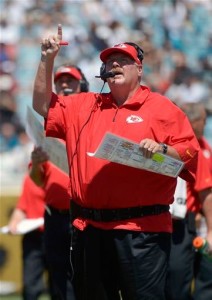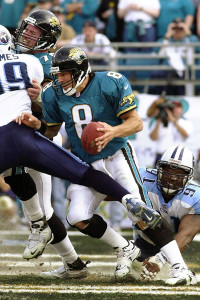You can’t just average Kansas City’s 100% winning percentage with Denver’s 88.8% rate, since a matchup of teams with 3-0 records (like New Orleans-Miami earlier this year) would produce a better average winning percentage. One simple method would be to use Neil’s method of deriving a team’s “true winning percentage”, which adds 5.5 wins and 5.5 losses to each team’s record. At 3-0, a team has a true winning percentage of only 0.607, so this method rewards teams that have had longer stretches of success. Do the math, and Kansas City has a 0.725 true winning percentage, while Denver is at 0.675. That gives this game an even 0.700 average true winning percentage. So where does that rank?
Pretty darn high. Last year, the highest average true winning percentage in a game was at 0.674, occurring when the 11-2 Texans faced the 10-3 Patriots in that letter jacket game. Denver-Kansas City will be just the fifteenth game since World War II where the two teams have an average true winning percentage of at least 0.700. [1]Five pre-WW II games show up: In 1926, the 11-0-2 Bears lost 7-6 to the 12-1-1 Frankford Yellow Jackets. In the last game of that season, a 14-1-1 Frankford tied a 10-2-1 Pottsville Maroons. Three … Continue reading Let’s look at the first 14, ranked in order of average true winning percentage:
#12-T) 8-1 Dallas at 9-0 Los Angeles, 1969 (Average True Winning Percentage: 0.700)
In a matchup identical to the one thus Sunday, the undefeated Rams topped the Cowboys, 24-23. Dallas would still win the NFL East and qualify for the playoffs. L.A. won in Washington the following week, before dropping the final four games of the year to finish 11-4, with the last of those games coming in the playoffs.
#12-T) 12-2 Washington at 12-2 Dallas, 1983 (Average True Winning Percentage: 0.700)
Washington was the defending Super Bowl champion, but the Cowboys had won 31-30 in week one in Washington. Dallas had lost its two games (to the Raiders and Chargers) by a combined three points, while the defending champs only loss since week one was a 48-47 thriller in Green Bay. The hype for this NFC East matchup was off the charts: Dallas was a three-point favorite, but Joe Theismann, John Riggins, and the Hogs led Washington to a 31-10 victory. Of course, Washington’s season ended in a Super Bowl loss, while Danny White and the Cowboys lost to the Rams in the Wild Card round of the playoffs.
#12-T) 13-1 Jacksonville at 11-3 Tennessee, 1999 (Average True Winning Percentage: 0.700)The Jaguars would end the season with a 15-3 record, with all three losses coming at the hands of the Titans. This game was the biggest rout of the three: Steve McNair threw five touchdowns, Eddie George rushed for 100 yards, and Tennessee won 41-14. A month later, Jacksonville took a 14-10 lead into the locker room of the AFC Championship Game, but the Titans won the second half 23-0.
#11) 7-0 Indianapolis at 8-0 New England, 2007 (Average True Winning Percentage: 0.703)
It’s hard to top undefeated Peyton Manning– and Tom Brady-led squads, and the only reason this game isn’t higher is because it didn’t come later in the year. The Patriots would finish the year 16-0, while Indianapolis’ only other meaningful loss came the following week in San Diego, when Manning threw six interceptions, Adam Vinatieri missed a last-second 29-yard field goal, and the Colts lost by two. The defending Super Bowl champion Colts held a 20-10 lead with ten minutes left, but Brady led two late scoring drives to give the Patriots the win.
#8-T) 10-1 Chicago at 10-1 Chicago, 1948 (Average True Winning Percentage: 0.705)
In week two, the visiting Bears beat the defending champion Cardinals 28-17. At the end of the season, the Cardinals traveled to, uh, Chicago with the NFL West title on the line. Johnny Lujack led the Bears to a 21-10 fourth quarter lead, but Charlie Trippi and Elmer Angsman responded with touchdowns that put the Cardinals back in the title game against the Eagles for the second year in a row. That game took place in a snowstorm the next week, though, and the Cardinals lost 7-0 in Philadelphia.
#8-T) 10-1 New York at 10-1 San Francisco, 1990 (Average True Winning Percentage: 0.705)
In the midst of the hype regarding the 2007 Patriots-Colts showdown, I wrote a long post about this Giants-49ers matchup. The 49ers won this battle 7-3, but the Giants won the war: New York won the NFC Championship Game in San Francisco, ending the 49ers’ threepeat hopes, and then defeated the Bills in Super Bowl XXV.
#8-T) 10-1 Green Bay at 10-1 Dallas, 2007 (Average True Winning Percentage: 0.705)
Tony Romo and the Cowboys were 6.5-point favorites, as the Cowboys only loss to date had come against the mighty Patriots. The Packers lost early (and then late) in the year against the Bears, and finished 13-3 after losing 37-27 in this memorable Thursday Night game. Terrell Owens caught 7 passes for 156 yards and a score, but the biggest surprise of the game was the solid play of Packers backup Aaron Rodgers, who relieved an injured Brett Favre. Both teams would eventually lose at home in the playoffs to the Giants.
#5-T) 11-0-2 Baltimore at 10-1-2 Los Angeles, 1967 (Average True Winning Percentage: 0.708)
Johnny Unitas and crew suffered one of football’s ultimate bad beats in ’67. With the addition of the expansion Saints, the NFL switched to a four-division format in 1967. The leaders of the Capital (Dallas), Century (Cleveland), and Central (Green Bay) divisions finished the year with 9 wins, but the Coastal Division housed the league’s two best teams. The Colts hadn’t lost a game all season, but a 34-10 loss in the the season finale in the Coliseum knocked Baltimore out of the playoffs (the teams tied earlier in the season in Baltimore). Los Angeles was a great team — Roman Gabriel had a monster year, and Deacon Jones, Merlin Olsen, Roger Brown, and Lamar Lundy were in their primes — but so were the Colts. Baltimore went 13-1 and won the NFL title the following season (before losing in Super Bowl III, of course), and the league’s four-division (with no wildcard) format was eliminated forever after the 1970 merger.
#5-T) 12-1 Pittsburgh at 11-2 Los Angeles, 1975 (Average True Winning Percentage: 0.708)
In case you haven’t picked up on this by now, the Rams of the late ’60s and ’70s were a very good team. The hype for this game would have been enormous, except it was a meaningless season finale for both teams. Pittsburgh did run Franco Harris 21 times for 126 yards, but Terry Bradshaw split time with Joe Gilliam, and the two combined to go 5 for 21 for 57 yards and three interceptions. The Rams didn’t even play starting quarterback James Harris, opting to give young Ron Jaworski a look. Los Angeles won 10-3, thanks to a five-yard touchdown run from Jaws in the final frame.
#5-T) 12-1 Denver at 11-2 Dallas, 1977 (Average True Winning Percentage: 0.708)
The networks should have been giddy about the prospect of a showdown between two great teams, featuring longtime teammates and rivals Roger Staubach and Craig Morton on the final week of the season. But much like the situation two years earlier, the game held no meaning for either team, as both had locked up the #1 seed in their respective conferences. Neither team showed much, and the teams combined for just 440 total yards. The teams would meet a few weeks later in Super Bowl XII, with the Cowboys crushing the Broncos, 27-10.
#4) 13-1 Indianapolis at 12-2 Seattle, 2005 (Average True Winning Percentage: 0.720)
Another meaningless regular season game, at least for one team. The Colts started the year 13-0, but were upset by Drew Brees and Michael Turner in the fourteenth game of the season. Indianapolis had locked up the 1 seed, and Manning barely played in Seattle. The Seahawks beat the Colts to secure the NFC’s 1 seed, as Matt Hasselbeck (17/21, 168 yards, 2 TDs) and Shaun Alexander (21 carries, 139 yards, two scores) dominated the Indianapolis defense. The Colts would lose to the Steelers in the Division round of the playoffs, while the Seahawks suffered the same fate against Pittsburgh in the Super Bowl.
#3) 10-1 Minnesota at 11-0 Los Angeles, 1969 (Average True Winning Percentage: 0.727)
Los Angeles topped the 9-0/8-1 showdown with Dallas two weeks later when the Rams hosted the Vikings. The Vikings had won 10 straight games, after blowing a 13-point lead on opening day when Fran Tarkenton — playing for the Giants — threw two fourth quarter touchdowns to give New York a 24-23 victory. Minnesota — led by Alan Page, Carl Eller, and Jim Marshall — looked to be one of the greatest teams of all time. Through 11 weeks, Minnesota led the league in points scored and points allowed, and had outscored opponents by 243 points (the Rams had the second best points differential at +118). The script held: Minnesota defeated Los Angeles 20-13, and then beat the Rams again in the playoffs in Minneapolis, before losing in Super Bowl IV.
#2) 10-0 San Francisco at 9-0 Cleveland, 1948 (Average True Winning Percentage: 0.732)
#1) 12-0 Cleveland at 11-1 San Francisco, 1948 (Average True Winning Percentage: 0.739)
AAFC history is often ignored, but these might have been the two best teams in professional football in 1948 (with apologies to the Eagles and both teams in Chicago). Behind quarterback Frankie Albert, and backs Johnny Strzykalski and Joe Perry, the 49ers led the AAFC in both points scored and points differential. The Browns would finish the year 15-0, and winning their third of what would be five straight championships (with the fifth coming in the NFL). In the team’s first matchup of the season, Otto Graham and Perry each rushed for first quarter touchdowns, and the game was tied 7-7 at halftime. Edgar Jones scored the lone second half touchdown to give Cleveland a 14-7 win in front of 83,000 fans, at the time the largest crowd to ever watch a pro football game. In a window into the tough, early days of pro football, 49ers coach Buck Shaw blamed the loss on the long trip and a case of stage fright.
The rematch would be highly anticipated, but Cleveland would need to do something unthinkable in today’s NFL to win. On November 21st, the Browns beat the Yankees in New York, and four days later, Cleveland won in Los Angeles against the Dons on Thanksgiving. But Cleveland’s rematch with San Francisco was scheduled for just three days after that! The difficulty of this ironman task was not lost on sportswriters of that time. San Francisco jumped out to a 21-10 lead, but Graham threw third-quarter touchdown passes to Marion Motley, Dub Jones, and Edgar Jones to put the Browns ahead for good.
References
| ↑1 | Five pre-WW II games show up: In 1926, the 11-0-2 Bears lost 7-6 to the 12-1-1 Frankford Yellow Jackets. In the last game of that season, a 14-1-1 Frankford tied a 10-2-1 Pottsville Maroons. Three years later, the 9-0-0 Packers traveled to New York and beat the 8-0-1 Giants, 20-6. In 1934, the 10-1 Lions lost 19-16 at home against the 11-0 Bears. A week later, the 10-2 Lions went to Chicago and lost 10-7 to the 12-0 Bears. |
|---|


